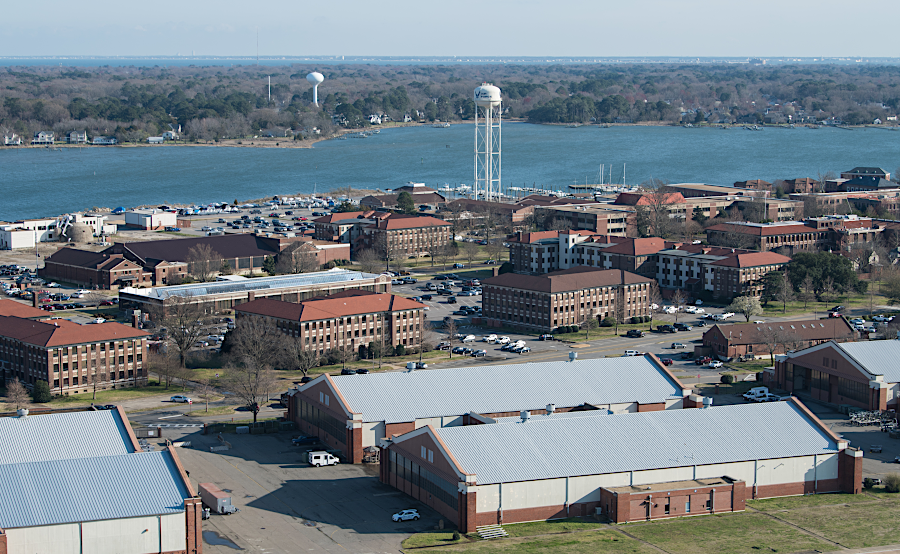Fort Eustis

in 1862, General McClellan bypassed the Confederate fortifications on Mulberry Point where Fort Eustis was later established
Source: Library of Congress, Central Virginia: showing Lieut. Gen'l. U.S. Grant's campaign and marches of the armies under his command in 1864-5 (US War Department. Engineer Bureau, between 1864 and 1869)
Camp Eustis was established on March 7, 1918, when the US Army took ownership of Mulberry Island. The name honored Brevet Brigadier General Abraham Eustis, who was the first commanding officer of Fort Monroe.
During World War I, 20,000 soldiers trained at Cap Eustis. They developed skills in launching, using, and retrieving observation balloons, working with the Lee Hall Balloon School and airplanes from Langley Air Field, and in railroad artillery. After the war ended, Camp Eustis became a demobilization camp for returning soldiers. The US Army chose to make the site into a permanent facility for heavy artillery training in 1923, and renamed it Fort Eustis.

utility rail branch locomotive engineer checking flatcars at Joint Base Langley-Eustis
Source: Joint Base Langley-Eustis
In the Great Depression, military training was terminated. The Federal Relief Agency operated a camp for homeless laborers, and the Bureau of Prisons ran a prison farm there.
In October 1936, the Works Progress Admininstration (WPA) closed its camp at Fort Eustis. The site was then treated as a sub-base of the Army's Langley Air Base and used as a bombing range for practice.
At the start of 1941, the military reactivated Fort Eustis. Its major focus was training troops in anti-aircraft artillery.
The bombing range practice continued until 1944. New observation towers were built by the start of 1943 and a Tow Target Area was established in the James River along the Mulberry Island shoreline. Other bommbing ranges for Langley were created at Plum Tree Island and on four islands off Cape Charles. A plane by mistake dropped three 100-pound bombs on Barracks T418 near the Tactical Motor Pool, and practice bombing at Fort Eustis ended later in 1944.
At the end of World War II, 26,000 Germans prisoners of war were indoctrinated with a six-day course in democracy, to de-Nazify them before return to Germany. After the war, the US Amy established its Transportation Corps and School at Fort Eustis. Soldiers trained in managing ports of embarkation and debarkation, and in railroad operations.1
The first permanent military heliport in the world, Felker Heliport, opened at Fort Eustis on Dec. 10, 1954. Initially it had two short airstrips and eight landing pads, configured like a wheel.
What is today Felker Army Airfield is one of the US Army's busiest airports, focused still on rotary-wing aviation. The high level of activity includes Navy, Coast Guard, and Army operations, because in the Hampton Roads area only fixed wing aircraft can train on the "outlying fields." Communications are enhanced because air traffic controllers are often former Navy personnel, familiar with the terminology of that service.2

US Army C-47 Chinook at Felker Army Airfield, in training operation at Joint Base Langley-Eustis
Source: Joint Base Langley-Eustis
The 2005 Base Realignment and Closure Act led to the transfer of the Army Transportation School headquarters to Fort Lee in 2010. The Training and Doctrine Command (TRADOC) moved from Fort Monroe to Fort Eustis, which was consolidated with Langley Air Force Base to create Joint Base Langley-Eustis.3
In 2025, TRADOC closed its doors at Joint Base Langley-Eustis and moved to Austin, Texas. TRADOC, which had been established at Fort Monroe in 1973, was deactivated. The organization was incorporated into the new Army Transformation and Training Command. The Virginia base lost nearly 650 civilian jobs in the reorganization.4
Links

sea level rise could flood the edges of Mulberry Island by 2040
Source: Commonwealth Center for Recurrent Flooding Resiliency, Sea Level Rise Projection
References
1. "History of Fort Eustis," Joint Base Langley-Eustis, https://www.jble.af.mil/About-Us/Fort-Eustis-History/; Linda Burdette, "When Langley Bombed Fort Eustis," Virginia Aeronautical Historical Society, April 2005, https://www.vahsonline.com/pdf/When-Langley-Bombed-Fort-Eustis.pdf (last checked September 25, 2025)
2. "Felker Army Airfield: The story behind Fort Eustis' 'hornet's nest'," Joint Base Langley-Eustis, December 10, 2012, https://www.jble.af.mil/News/Features/Display/Article/260558/ (last checked October 23, 2020)
3. "Fort Eustis," Joint Base Langley-Eustis, https://www.jble.af.mil/Units/Army/ (last checked October 23, 2020)
4. "After 52 years of service, TRADOC to inactivate under new Army reorganization," The Virginian-Pilot, September 11, 2025, https://www.pilotonline.com/2025/09/11/tradoc-inactivate/; "TRADOC general says merger will be 'clunky' but effective as Fort Eustis command deactivates," WHRO, September 17, 2025, https://www.whro.org/military-veterans/2025-09-17/tradoc-general-says-merger-will-be-clunky-but-effective-as-fort-eustis-command-deactivates (last checked September 17, 2025)

Mulberry Island at the start of the Civil War
Source: National Archives, Sheet No. 1 Military Reconnaissance

view of Fort Eustis component of Joint Base Langley-Eustis, from helicopter above Felker Army Airfield
Source: Joint Base Langley-Eustis
The Military in Virginia
Virginia Places





